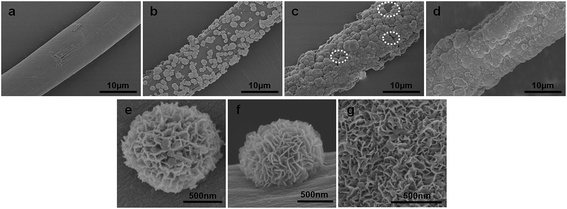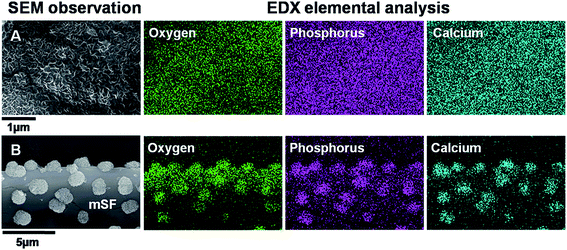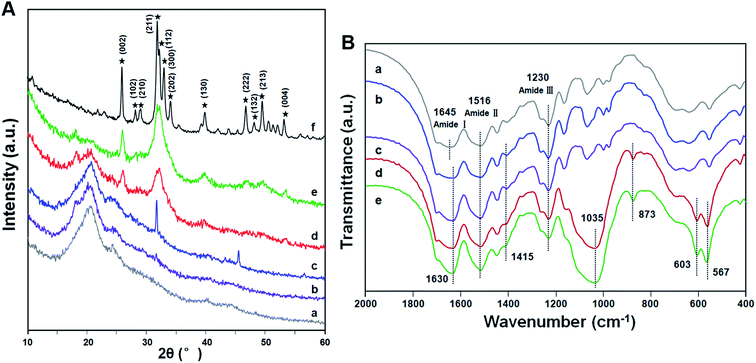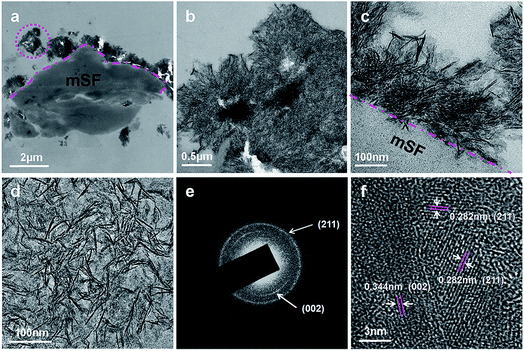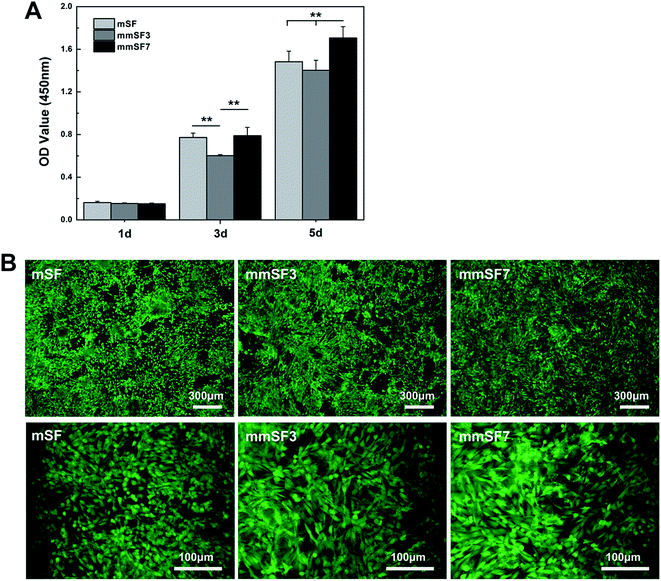Formation of hierarchical bone-like apatites on silk microfiber templates via biomineralization†
Zongpu Xua,
Liyang Shib,
Doudou Hua,
Binhui Hua,
Mingying Yanga and
Liangjun Zhu*a
aInstitute of Applied Bioresource Research, College of Animal Sciences, Zhejiang University, Room C319, Agriculture Life and Environmental Sciences Building, 866 Yuhangtang Road, Hangzhou 310058, P. R. China. E-mail: ljzhu@zju.edu.cn; Fax: +86 571 88982185; Tel: +86 571 88982185
bScience for Life Laboratory, Division of Polymer Chemistry, Department of Chemistry-Ångström, Uppsala University, Uppsala SE 751 21, Sweden
First published on 29th July 2016
Abstract
Silk microfibers (mSF) are attractive in tissue engineering because of their good plasticity and significant mechanical reinforcement effect. Bone-like apatites coated on the surface of mSF through biomineralization have been rarely reported. In this study, mSF with lengths of 200–300 μm were prepared and used as templates for biomineralization. By immersing in 1.5 times stimulated body fluid (1.5 × SBF), a hierarchical bone-like apatite layer can be formed on the surface of the mSF, which was developed in a time-dependent manner. As basic units, hydroxyapatite (HAp) nanoplates will assembly into microspheres with sophisticated flower-like structures and then, the microspheres gradually aggregated into a complete mineral layer overcovering the mSF. Multiple methods were used to characterize and analyze the organic/inorganic composites, including their morphology, structural and crystallographic properties, as well as the interface between the two different phases. The template effect of the mSF in the biomineralization process was investigated and a possible mechanism was proposed. In addition, cytocompatibility evaluation showed the mineralized silk microfibers (mmSF) tended to achieve better outcomes for cell growth and proliferation. This work provides a facile approach towards the development of mSF/HAp biocomposites, which possess potential applications in bone tissue engineering.
1. Introduction
Native bone presents a complex ordered structure consisting of collagen molecules as the organic phase and mineral crystals as the inorganic phase.1,2 The bone minerals, in forms of carbonated apatite, exhibit nanoscale plate-like structures embedded axially parallel to the collagen fibrils.3 Since hydroxyapatite (HAp) is not only chemically similar to the mineral components in bone, but also have good biocompatibility, remarkable osteoinductivity and strong affinity to hard tissues, they have been widely applied as biomaterials in bone tissue engineering.4–6 Among the diverse sizes and shapes of HAp, those with a nanosized with hierarchical structure can perfectly mimic natural biominerals.7,8 Therefore, various techniques have been used to synthesize nanostructured HAp, including sol–gel methods,9 hydrothermal methods,10,11 emulsion methods12 and template methods.13,14 As the nucleation and growth of bone minerals are regulated by collagen, utilizing organic templates in a particular protein via simulating the biomineralization process to create novel biomimetic organic/inorganic composites has become a fascinating choice.15,16Silk fiber, a natural animal protein fiber extracted from silkworm cocoons, possesses excellent physicochemical and biological properties, highlighted by its superior mechanical strength, which is quite important for the design of bone repair materials.17–20 Some studies have reported that silk films,21 silk nanofibers22 or silk hydrogels23 can serve as templates to induce HAp mineralization. However, to prepare such materials the silk fiber must be dissolved in solution, which inevitably disrupted its well-ordered inner structure,24 leading to a significant drop in its mechanical behavior. Some researchers have tried to synthesize minerals using long silk fibers or silk fabric as templates25–27 in order to retain the good mechanical properties. But, as we know, due to their lack of plasticity, it is difficult to apply these materials in bone tissue engineering to develop homogenous constructs with enhanced mechanical properties.
Silk microfibers (mSF, dozens to hundreds micrometers in length) directly obtained from long silk fibers, by contrast, have gained a lot of attention recently.28,29 Due to their small size and water insolubility, mSF can be uniformly dispersed in various matrixes to fabricate mSF-reinforced biocomposites. For example, the Kaplan group added mSF into silk scaffolds30 and silk hydrogels,31 respectively, and the obtained materials showed a significant improvement in their mechanical performance. We used mSF to prepare an mSF/chitosan blended membrane32 in which the mSF also acted effectively as a reinforced phase to enhance the elastic modulus for dozens of times. Moreover, these fine-scale mSF displayed good biological efficiency both in vitro and in vivo.30–32 Nevertheless, there are almost no reports describing the fabrication of mSF/HAp materials, which may have predictable application as injectable bone defect fillers or as a mechanical reinforcement in bone tissue-engineered scaffolds.
In the current study, we have prepared relatively homogenous mSF in lengths of 200–300 μm via alkali-hydrolysis and milling-selection methods, and then used them as templates for biomineralization. Bone-like HAp apatites can be spontaneously formed in a hierarchical fashion on the surface of the mSF with good interface combination between the organic and inorganic phases, and the mSF/HAp biocomposites achieved better cellular outcomes.
2. Results and discussion
2.1 The morphology of silk microfibers (mSF) and mineralized silk microfibers (mmSF)
A two-step method using alkali-hydrolysis and milling-selection was comprehensively applied to prepare the mSF used in this study. From visual inspection the mSF was a fine white powder and from microscopic observations they were in a fiber form (Fig. 1). The diameter of the mSF was about 10 μm and the length was kept homogenous within 200–300 μm (Fig. 1b) because the long silk fibers had been chopped into short fibers under the alkaline conditions and the tiny silk particles were successfully removed using a sieve. The surface of the mSF was relatively smooth with hardly any attachment (Fig. 1c), mainly due to the total degumming of sericin. | ||
| Fig. 1 (a) A digital image of the mSF. (b) FE-SEM images of the mSF at low magnification and (c) high magnification. | ||
The biomineralization of the mSF was carried out in 1.5 × SBF, an effective biomimetic mineralizing solution,33,34 which provides an in situ mineral deposition environment. Although nothing significantly changed in the mSF after immersion in the 1.5 × SBF for 1 d (Fig. 2a), two days later emerged many spherical and near-spherical crystals onto the mSF surface, isolated or connected (Fig. 2b). The microstructure in vertical and lateral views of representative mineral crystals are shown in Fig. 2e and f. Actually these flower-like microspheres with diameters of around 1 μm presented sophisticated structures, which were comprised of many nanosized plate-like crystals in various orientations. As basic building blocks, nanoplates can self-assemble into different morphologies and architectures, which provide an efficient “bottom-up” route to fabricate bone-like hierarchical materials.7,35
Upon increasing the mineralization time, a growing number of crystals were continually formed and they tended to aggregate together, thus developing into a hierarchical mineral layer. After immersion in 1.5 × SBF for 5 d, the layer was not very complete as some intervals still existed (Fig. 2c). When it came to 7 d, the mSF had been overcovered (Fig. 2d) and the surface of the mineral layer was fairly rough, which was attributed to the nanoplates confluence (Fig. 2g). The time-dependent manner of mineral deposition was also reflected in the thermogravimetric analysis shown in Fig. S1 (see the ESI).† All the samples showed mass-loss behavior as the temperature was increased, while at the end the remaining weight percentage of the mmSF increased with prolonged mineralization time.
2.2 Characterization and analysis of the deposited mineral
To visually demonstrate the elemental spatial distribution of the deposited minerals, EDX elemental analysis in area scan mode was performed. Three elements (oxygen, phosphorus and calcium) were detected in the mineral layer of the mmSF (Fig. 3A) and they distributed in the whole area at a very high density, indicating the mineral was a type of calcium phosphate. Also, the mapping result in Fig. 3B clearly shows that these elements were mainly concentrated in areas consistent with the shape of the single crystals on the mSF, especially calcium.XRD measurements were used to further analyze the crystallographic properties of the mSF and mmSF for various mineralization periods. Pure HAp was selected as reference with all the characteristic diffraction peaks designated in accordance with the standard card (JCPDS 09-0432) (Fig. 4Af). The broad peak at 20.7° (Fig. 4Aa) was attributed to the β-sheet crystalline domain of the mSF,36 as the inner well-ordered structure still existed. No significant changes happened after mineralization for 1 d, but two intense peaks at 31.73° and 45.47° corresponding to the (211) and (222) lattice planes emerged on the 3rd day, which was due to the formation of spherical mineral crystals that were detectable by XRD. Upon increasing the mineralization time from 3 d to 5 d and 7 d, one interesting phenomenon was that the (222) lattice plane disappeared, while the peak at 25.93° corresponding to the (002) lattice plane clearly appeared and gradually strengthened, suggesting the lattice plane transformed during the confluence process from independent crystals to a connected mineral layer. In addition, the peak observed for the (211) lattice plane broadened and tended to divide into multiple peaks, which was a result of the decreased crystallinity.37
FTIR spectroscopy was applied to identify the functional groups and analyze the molecular structure of the mmSF using the mSF as a reference (Fig. 4B). Amide I (C![[double bond, length as m-dash]](https://www.rsc.org/images/entities/char_e001.gif) O stretching), amide II (N–H deformation and C–N stretching) and amide III (C–N stretching and N–H deformation) are the characteristic peaks observed for silk fibroin and appeared at 1645 cm−1, 1516 cm−1 and 1230 cm−1, respectively in curve a. Amide I shifted to a lower wavenumber at ∼1630 cm−1 after mineralization, indicating an interaction had occurred between Ca2+ and COO−.38 Although no mineral deposition was observed on the mSF at day 1 according to SEM images, the Ca2+ in 1.5 × SBF can bond with COO− to promote the initial nucleation step. The mineral crystals grew to certain sizes after mineralization for 3 days, but the relevant curve c had no significant change because the mineral deposition was small during this period. Nevertheless, a series of peaks emerged after mineralization for 5 and 7 d. The intense peaks at 567 cm−1 and 603 cm−1 were attributed to the O–P–O bending vibrations and the peaks at 962 cm−1 and 1035 cm−1 were assigned to the P–O stretching vibrations of the phosphate groups.39 The peak at 873 cm−1 and the weak peak at 1415 cm−1 should be induced by the absorption bands of the CO32− groups,11,40 which probably come from the atmosphere during the stirring process. It is the CO32− incorporation that leads to the decreased crystallinity as the peak for the (211) lattice plane broadened in the XRD pattern.
O stretching), amide II (N–H deformation and C–N stretching) and amide III (C–N stretching and N–H deformation) are the characteristic peaks observed for silk fibroin and appeared at 1645 cm−1, 1516 cm−1 and 1230 cm−1, respectively in curve a. Amide I shifted to a lower wavenumber at ∼1630 cm−1 after mineralization, indicating an interaction had occurred between Ca2+ and COO−.38 Although no mineral deposition was observed on the mSF at day 1 according to SEM images, the Ca2+ in 1.5 × SBF can bond with COO− to promote the initial nucleation step. The mineral crystals grew to certain sizes after mineralization for 3 days, but the relevant curve c had no significant change because the mineral deposition was small during this period. Nevertheless, a series of peaks emerged after mineralization for 5 and 7 d. The intense peaks at 567 cm−1 and 603 cm−1 were attributed to the O–P–O bending vibrations and the peaks at 962 cm−1 and 1035 cm−1 were assigned to the P–O stretching vibrations of the phosphate groups.39 The peak at 873 cm−1 and the weak peak at 1415 cm−1 should be induced by the absorption bands of the CO32− groups,11,40 which probably come from the atmosphere during the stirring process. It is the CO32− incorporation that leads to the decreased crystallinity as the peak for the (211) lattice plane broadened in the XRD pattern.
Based on above results and analyses, we concluded that the deposited minerals was comprised of a carbonate apatite similar to natural bone minerals.3
2.3 The interface between the minerals and mSF
In order to deeply understand the interface between the inorganic minerals and organic mSF, the cross-sections of the mmSF at 7 d were used for TEM observations. A clear interface can be observed in Fig. 5a and c, but unlike the overcover effect of mineral crystals in the SEM image, some dropped out from the mSF surface (shown in the purple dotted box of Fig. 5a), which may be caused by the powerful cutting stress used when preparing the ultrathin sections for TEM. Fig. 5b shows the magnified cross-section of the mineral crystals, which exhibit similar flower-like structures to those observed using SEM shown in Fig. 2e and f. As mentioned previously, the nanoplates self-assembled into sophisticated structures, herein the needle-like crystals (actually the cross-sections of the plate-like crystals) were aggregated with random orientations.The HR-TEM observations are shown in Fig. 5d–f, from which more detailed information on the crystal properties could be revealed. Two main diffraction rings were detected using the SAED image (Fig. 5e), referring to the (211) and (002) lattice planes. Moreover, Fig. 5f directly shows the lattice images, for the lattice spacings of 0.282 nm and 0.344 nm corresponding to the (211) and (002) lattice planes,41 which were in accordance with the XRD analysis.
2.4 The biomineralization process of the mSF
In the biomineralization process, the organic templates regulate the crystal growth and morphology. Considered as initial nucleation sites, the anionic groups of the templates can chelate calcium ions, arrange the structure and modulate the formation of HAp crystals.42,43 Unlike materials derived from silk solution in which the anionic groups are adequately exposed, the original silk fibers with insufficient anionic groups probably weaken its Ca2+ bonding capability. For example, Takeuchi et al.25 found no apatite could be deposited on degummed long silk fibers after 7 d of mineralization, with or without CaCl2 solution pretreatment. Aiming to provide more active sites to connect with Ca2+, Korematsu et al.26,27 modified silk fibers using graft polymerization through covalent linkages, however, the small amount of mineral deposition indicated it was not a very effective method. However, in our study the mSF can successfully be used as a template to promote the formation of a hierarchical HAp mineral layer. We deduced that these results came from the influence of the alkaline hydrolysis step because the long silk fibers were chopped into relatively short mSF and the surface of the mSF were partly “remodeled” by the OH− ions, as more COO− groups were exposed to act as initial Ca2+ binding sites.44,45Based on the previously reported mechanism and our observations in this study, a schematic diagram of HAp formation using the mSF templates was proposed (Fig. 6). The mechanism includes four stages: nucleation, growth, self-assembly and aggregation. In the early stage of mineralization, Ca2+ in 1.5 × SBF can bond with the COO− groups in the mSF to form ion complexes via electrostatic interactions. The COO–Ca complexes can then further interact with PO43−, thus initiating the HAp nucleation stage. When more and more Ca2+ and PO43− are attracted, HAp nanoplates of a certain size gradually develop. As the basic unit, they will assembly into HAp microspheres exhibiting sophisticated flower-like structures. As mineralization proceeds, the HAp microspheres aggregate into a hierarchical coverage layer, not only achieving a good combination between the organics and inorganics but also generate the novel mSF/HAp biocomposite.
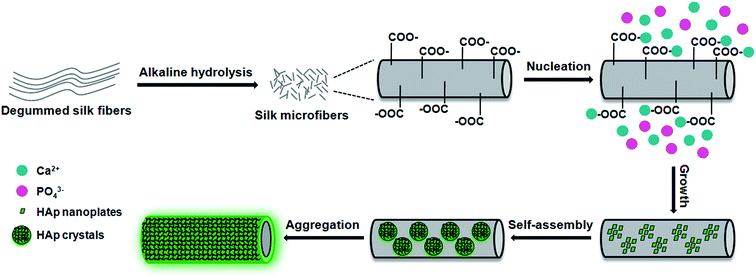 | ||
| Fig. 6 A schematic representation of the biomineralization process including the nucleation, growth, self-assembly and aggregation of the mSF. | ||
2.5 The biocompatibility of the mSF and mmSF
In this study, the biocompatibility of the mSF (silk microfibers without mineralization), mmSF3 (silk microfibers after 3 d of mineralization) and mmSF7 (silk microfibers after 7 d of mineralization) was tested on human osteosarcoma MG-63 cells, which express many characteristics of relatively immature osteoblasts.46 The viability of the cells at different time points was measured using a CCK-8 kit and the results are shown in Fig. 7. At 1 d, the OD405 of three groups were similar, as the addition of materials created a new environment and an adaption period was needed for the cells. At 3 d, significant differences (p < 0.01) were observed both between the mmSF3 group and the other groups, respectively. One plausible reason was the incomplete mineral surface of mmSF3 improved the foreign heterogeneity when exposed to cells, while the mSF and mmSF7 were nearly homogeneous. After 5 days of culture, the cells treated with mmSF7 achieved the highest viability and presented significant differences (p < 0.01) with the other two groups. The Calcein-AM staining images also supported the CCK-8 assay results. Under low magnification, the cells had overgrown the whole area in the mmSF7 group while not completely in the mSF and mmSF3 groups. Interestingly, no significant difference (p > 0.05) was observed between the mSF and mmSF3 groups, for the foreign heterogeneity did not influence the relatively long term proliferation of the MG-63 cells. Under high magnification, the cellular morphology exhibited a more prolonged state when treated with mmSF3 or mmSF7 when compared with the mSF. The improved morphology indicated the cells can sense the surrounding microenvironment and the HAp-containing materials promoted their growth and proliferation. The mSF/HAp biocomposites showed good cytocompatibility, which is important and necessary for further application in bone tissue engineering.3. Experimental section
3.1 Materials
Silk cocoons of Bombyx mori were provided by the Institute of Huzhou Cocoon Testing (PR China). The 1.5 times simulated body fluid (1.5 × SBF) was prepared according to the components and procedure reported in the literature,47 which has 1.5 times the ion concentration of SBF. NaCl, NaHCO3, KCl, K2HPO4·3H2O, MgCl2·6H2O, HCL, CaCl2, Na2SO4 and Tris, as well as NaHCO3 and NaOH were purchased from Sinopharm Chemical Reagent Co., Ltd. Pure hydroxylapatite (<100 nm) was purchased from Aladdin Industrial Corporation. All reagents were of analytical grade and were used as received without any further purification.3.2 Preparation of the mSF
mSF were obtained using a two-step method, namely alkali-hydrolysis and milling-selection. Firstly, silk cocoons were cut into pieces and degummed twice in 0.5 wt% Na2CO3 solution at 100 °C, each for 30 min. After thoroughly rinsing and drying, the degummed silk fibers were immersed in 1 M NaOH solution at 40 °C for 5 h. The alkaline hydrolysis was stopped by removing alkaline liquid and washing the degraded product with deionized water. Then, the dried product was bead-milled to further disperse and shortening the silk fibers, and finally the as-prepared mSF was sieved to filter out the ultrashort silk fibers.3.3 Biomineralization of the mSF
A certain amount of mSF was uniformly dispersed in 1.5 × SBF (1 g![[thin space (1/6-em)]](https://www.rsc.org/images/entities/char_2009.gif) :
:![[thin space (1/6-em)]](https://www.rsc.org/images/entities/char_2009.gif) 1000 mL) with magnetically stirring to prevent the mSF from coagulating. The mineralization process was kept at 37 °C and the 1.5 × SBF was changed every day. At a set time of 1, 3, 5 and 7 d, the mineralized silk microfibers (mmSF) were removed and washed with deionized water, then lyophilized using a vacuum freeze dryer (Boyikang, FD-1-50, China).
1000 mL) with magnetically stirring to prevent the mSF from coagulating. The mineralization process was kept at 37 °C and the 1.5 × SBF was changed every day. At a set time of 1, 3, 5 and 7 d, the mineralized silk microfibers (mmSF) were removed and washed with deionized water, then lyophilized using a vacuum freeze dryer (Boyikang, FD-1-50, China).
3.4 Characterization of the mSF and mmSF
![[thin space (1/6-em)]](https://www.rsc.org/images/entities/char_2009.gif) :
:![[thin space (1/6-em)]](https://www.rsc.org/images/entities/char_2009.gif) 100 and pressed into tablets. An FTIR spectrometer (8400S, Shimadzu, Japan) was used to record the infrared spectra in the range of 400–4000 cm−1. Each spectrum was obtained by the accumulation of 80 scans with a resolution of 4 cm−1.
100 and pressed into tablets. An FTIR spectrometer (8400S, Shimadzu, Japan) was used to record the infrared spectra in the range of 400–4000 cm−1. Each spectrum was obtained by the accumulation of 80 scans with a resolution of 4 cm−1.3.5 Cell proliferation and morphology
Human osteosarcoma MG-63 cells (kindly provided by Prof. Juming Yao from Zhejiang Sci-Tech University and carefully preserved in our laboratory) were employed to evaluate the cytocompatibility of the mSF (silk microfibers without mineralization), mmSF3 (silk microfibers after 3 d of mineralization) and mmSF7 (silk microfibers after 7 d of mineralization). The MG-63 cells were cultured in high-glucose Dulbecco's modified eagle's medium (DMEM) culture medium with 10% fetal bovine serum (FBS, Gibco®, USA), 100 U mL−1 penicillin and 100 μg mL−1 streptomycin at 37 °C in a humidified air containing 5% CO2. The cells were seeded in 48-well plates with 1 × 104 cells in each well and cultured for 6 h beforehand, then sterilized samples of the mSF, mmSF3 and mmSF7 were added at a concentration of 1 mg mL−1. After being co-cultured for 1, 3 and 5 d (the culture medium was changed every 2 days), the viability of the cells was investigated using a CCK-8 (Cell Counting Kit-8) assay according to the manufacturer's protocol (Biosharp). The optical density values at 450 nm (OD450) were detected using a microplate reader (Elx808, Biotek, USA) and the background absorbance of wells containing no cells was subtracted from each group. The results were presented as the mean value ± the standard deviation (n = 5) and statistically significant differences (**p < 0.01) were determined using one-way ANOVA with t-test. In addition, a calcein-AM staining kit (Yeason) was used to further illustrate the proliferation and morphology of the live cells at 5 d of culture. The stained cells were observed under a fluorescence microscope (IX51, Olympus, Japan).4. Conclusions
This study provides a facile method to develop mSF-HAp composites via biomineralization. mSF can be used as a template to mediate the formation of hierarchical HAp mineral layer aggregated by flower-like microspheres, which were assembled from nanoplate building blocks. In addition, the organic/inorganic biocomposites exhibited good cytocompatibility. The mSF possess a significant mechanical reinforcement effect and HAp has remarkable osteoinductivity, so we can speculate that the as-prepared materials may achieve good performance in bone tissue engineering. A subsequent study based on this novel biomaterial, such as injectable bone defect fillers or reinforcement in bone repair scaffolds will be further investigated.Acknowledgements
This study is supported by the Earmarked Fund (CARS-22-ZJ0402) for China Agriculture Research System (CARS) and the National Natural Science Foundation of China.References
- M. M. Stevens, Mater. Today, 2008, 11, 18–25 CrossRef CAS.
- J. Henkel, M. A. Woodruff, D. R. Epari, R. Steck, V. Glatt, I. C. Dickinson, P. F. Choong, M. A. Schuetz and D. W. Hutmacher, Bone Res., 2013, 1, 216–248 CrossRef CAS PubMed.
- S. Weiner and H. D. Wagner, Annu. Rev. Mater. Res., 1998, 28, 271–298 CrossRef CAS.
- M. W. Laschke, A. Strohe, M. D. Menger, M. Alini and D. Eglin, Acta Biomater., 2010, 6, 2020–2027 CrossRef CAS PubMed.
- K. Masanori, Biol. Pharm. Bull., 2013, 36, 1666–1669 Search PubMed.
- H. Yang, X. Yan, M. Ling, Z. Xiong, C. Ou and W. Lu, Int. J. Mol. Sci., 2015, 16, 6113–6123 CrossRef CAS PubMed.
- H. Zhou and J. Lee, Acta Biomater., 2011, 7, 2769–2781 CrossRef CAS PubMed.
- M. Sadat-Shojai, M. T. Khorasani, E. Dinpanah-Khoshdargi and A. Jamshidi, Acta Biomater., 2013, 9, 7591–7621 CrossRef CAS PubMed.
- M. H. Fathi and A. Hanifi, Mater. Lett., 2007, 61, 3978–3983 CrossRef CAS.
- H. B. Zhang, K. C. Zhou, Z. Y. Li and S. P. Huang, J. Phys. Chem. Solids, 2009, 70, 243–248 CrossRef CAS.
- M. G. Ma, Int. J. Nanomed., 2012, 7, 1781–1791 CrossRef CAS PubMed.
- W. Y. Zhou, M. Wang, W. L. Cheung, B. C. Guo and D. M. Jia, J. Mater. Sci.: Mater. Med., 2008, 19, 103–110 CrossRef CAS PubMed.
- K. Lin, X. Liu, J. Chang and Y. Zhu, Nanoscale, 2011, 3, 3052–3055 RSC.
- S. K. Saha, A. Banerjee, S. Banerjee and S. Bose, Mater. Sci. Eng., C, 2009, 29, 2294–2301 CrossRef CAS.
- Y. Cai and J. Yao, Nanoscale, 2010, 2, 1842–1848 RSC.
- J. Ma, J. Wang, X. Ai and S. Zhang, Biotechnol. Adv., 2014, 32, 744–760 CrossRef CAS PubMed.
- J. Melke, S. Midha, S. Ghosh, K. Ito and S. Hofmann, Acta Biomater., 2015, 31, 1–16 CrossRef PubMed.
- F. Mottaghitalab, H. Hosseinkhani, M. A. Shokrgozar, C. Mao, M. Yang and M. Farokhi, J. Controlled Release, 2015, 215, 112–128 CrossRef CAS PubMed.
- B. Kundu, R. Rajkhowa, S. C. Kundu and X. Wang, Adv. Drug Delivery Rev., 2012, 65, 457–470 CrossRef PubMed.
- N. Kasoju and U. Bora, Adv. Healthcare Mater., 2012, 1, 393–412 CrossRef CAS PubMed.
- Y. Li, Y. Cai, X. Kong and J. Yao, Appl. Surf. Sci., 2008, 255, 1681–1685 CrossRef CAS.
- K. Wei, Y. Li, K. O. Kim, Y. Nakagawa, B. S. Kim, K. Abe, G. Q. Chen and I. S. Kim, J. Biomed. Mater. Res., Part A, 2011, 97, 272–280 CrossRef PubMed.
- Y. Jin, B. Kundu, Y. Cai, S. C. Kundu and J. Yao, Colloids Surf., B, 2015, 134, 339–345 CrossRef CAS PubMed.
- C. Holland, A. E. Terry, D. Porter and F. Vollrath, Polymer, 2007, 48, 3388–3392 CrossRef CAS.
- A. Takeuchi, C. Ohtsuki, T. Miyazaki, H. Tanaka, M. Yamazaki and M. Tanihara, J. Biomed. Mater. Res., Part A, 2003, 65, 283–289 CrossRef PubMed.
- A. Korematsu, T. Furuzono, S. Yasuda, J. Tanaka and A. Kishida, J. Mater. Sci.: Mater. Med., 2004, 39, 3221–3225 CrossRef CAS.
- A. Korematsu, T. Furuzono, S. Yasuda, J. Tanaka and A. Kishida, J. Mater. Sci.: Mater. Med., 2005, 16, 67–71 CrossRef CAS PubMed.
- B. Q. Pei, H. Li, G. Zhu, D. Y. Li, Y. B. Fan and S. Q. Wu, BioMed Res. Int., 2013, 2013, 945–953 Search PubMed.
- X. Li, Y. Yang, Y. Fan, Q. Feng, F. Z. Cui and F. Watari, J. Biomed. Mater. Res., Part A, 2014, 102, 1580–1594 CrossRef PubMed.
- B. B. Mandal, A. Grinberg, E. S. Gil, B. Panilaitis and D. L. Kaplan, Proc. Natl. Acad. Sci. U. S. A., 2012, 109, 7699–7704 CrossRef CAS PubMed.
- S. Yodmuang, S. L. McNamara, A. B. Nover, B. B. Mandal, M. Agarwal, T. A. Kelly, P. H. Chao, C. Hung, D. L. Kaplan and G. Vunjak-Novakovic, Acta Biomater., 2014, 11, 27–36 CrossRef PubMed.
- Z. P. Xu, L. Y. Shi, M. Y. Yang, H. P. Zhang and L. J. Zhu, J. Mater. Chem. B, 2015, 3, 3634–3642 RSC.
- X. Liu, L. A. Smith, J. Hu and P. X. Ma, Biomaterials, 2009, 30, 2252–2258 CrossRef CAS PubMed.
- M. Yang, G. Zhou, Y. Shuai, J. Wang, L. Zhu and C. Mao, J. Mater. Chem. B, 2015, 28, 2455–2462 RSC.
- K. Bleek and A. Taubert, Acta Biomater., 2013, 9, 6283–6321 CrossRef CAS PubMed.
- U. J. Kim, J. Park, H. J. Kim and D. L. Kaplan, Biomaterials, 2005, 26, 2775–2785 CrossRef CAS PubMed.
- Y. Huang, G. Zhou, L. Zheng, H. Liu, X. Niu and Y. Fan, Nanoscale, 2012, 4, 2484–2490 RSC.
- F. Lin, Y. C. Li, J. Jin, Y. R. Cai, K. M. Wei and J. M. Yao, Mater. Chem. Phys., 2008, 111, 92–97 CrossRef CAS.
- X. Y. Zhao, Y. J. Zhu, J. Zhao, B. Q. Lu, F. Chen, C. Qi and J. Wu, J. Colloid Interface Sci., 2014, 416, 11–18 CrossRef CAS PubMed.
- H. P. Zhang, X. Y. Wang, S. J. Min, M. Mandal, M. Y. Yang and L. J. Zhu, Ceram. Int., 2014, 40, 985–991 CrossRef CAS.
- M. Yang, Y. Shuai, C. Zhang, Y. Chen, L. Zhu, C. Mao and H. OuYang, Biomacromolecules, 2014, 15, 1185–1193 CrossRef CAS PubMed.
- J. D. Hartgerink, E. Beniash and S. I. Stupp, Science, 2001, 294, 1684–1688 CrossRef CAS PubMed.
- F. Z. Cui, Y. Wang, Q. Cai and W. Zhang, J. Mater. Chem., 2008, 18, 3835–3840 RSC.
- L. Wang, C. Li and M. Senna, J. Nanopart. Res., 2007, 9, 919–929 CrossRef CAS.
- P. Taddei, E. Pavoni and M. Tsukada, J. Raman Spectrosc., 2016, 47, 731–739 CrossRef CAS.
- C. C. Ribeiro, C. C. Barrias and M. A. Barbosa, Biomaterials, 2004, 25, 4363–4373 CrossRef CAS PubMed.
- T. Kokubo and H. Takadama, Biomaterials, 2006, 27, 2907–2915 CrossRef CAS PubMed.
Footnote |
| † Electronic supplementary information (ESI) available: The thermogravimetric analysis results. See DOI: 10.1039/c6ra17199k |
| This journal is © The Royal Society of Chemistry 2016 |

